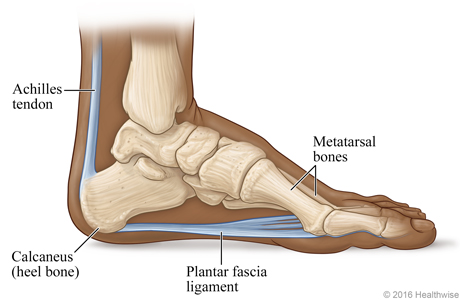December 21st, 2017
My Embarrassing History

At the beginning of my junior year of collegiate cross country, besides having a questionable hairstyle, I began noticing a pain in my heel. ¬†At first I would only feel it when I was running. ¬†Soon my first few steps each morning felt like walking on broken glass. It quickly began hurting all the time. Like a typical thick-skulled male athlete I didn’t tell my coach or athletic trainers fearing they would tell me not to run. ¬†I figured I had a stress fracture in my heel, and if I could just get through the season I‚Äôd have time between cross country and track to let it heal. ¬†The pain got to the point where I could no longer ignore it. ¬†I would wince with each foot strike and limp with each stride.
What Is It?
Fortunately, I did not have a stress fracture.  What I did have was plantar fasciitis.  The plantar fascia is a thick band of connective tissue running from the ball of the foot to the heel. Overuse can cause the point where the fascia attaches to the heel to become irritated.

In some cases the fascia pulls so hard at the heel that a heel spur can develop.  When the fascia pulls at your heel it creates a little gap.  Your body responds by filling that gap with bone. Unless you have the spur surgically removed, it’s not going anywhere.  Fortunately, with the right treatment you can be completely free of plantar fasciitis pain even with a spur.
How Do You Fix It?
Even if two people receive the same diagnosis it doesn’t mean their treatment should be the same.  Each person has their own unique anatomy, biomechanics, and injury history, and those factors need to be accounted for when creating a game plan for treatment.
Most people coming to see us with plantar fasciitis receive cold laser therapy.  This is typically used over dry needling because… well… needles in the feet?  No, thanks.  Cold laser is a painless treatment that involves using light energy to stimulate tissue healing.  This is typically followed by some light soft tissue work on the calf and bottom of the foot.
The meat and potatoes of our treatment lies in taking our patients through specific exercise to strengthen the fascia.  Strengthening the fascia fixes the cause of the problem and ensures it doesn’t come back.  The level and intensity of the exercise will vary depending on the person.
Additionally, depending on the foot type, the patient may receive taping to support the bottom of the foot.
What Can I Do Now?
PF can be very stubborn, but there are things you can do to prevent it from getting worse.
- Flip flops:  Have you ever tried running in flip flops?  It’s quite difficult.  In fact it’s impossible to walk normally in flip flops without them falling off.  They’re not good for your feet, so definitely avoid them if you have PF.
- Wearing cushioned, supportive shoes will help relieve the stress on the plantar fascia.
- Night splints that pull your foot back have not been shown to be very helpful.  They’re often recommended by podiatrists, physical therapists, and chiropractors, but the research behind them is lacking.
- Get it taken care of!  Plantar fasciitis can be fixed.  Start conservative (chiropractic) before trying something more invasive (cortisone or surgery).  Find a medical professional you trust. We have helped many people with plantar fasciitis become pain free, and we would love to help you as well!
To learn more about your options or to schedule an appointment, click the button below.





